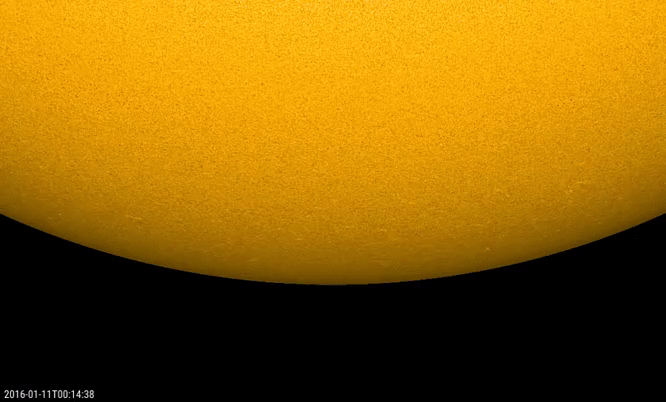The STCE Newsitem of 9 September 2015 discussed some peculiarities of polar faculae, the relatively bright points that sometimes can be seen near the solar poles. On the highly contrasted SDO/HMI image from 11 January 2016 underneath, two red arrows point out some of these polar faculae. There is a significant difference in outlook between these puny dots and the much brighter main zone faculae (dashed blue), as well as the much bigger and darker sunspots (green).

The number of polar faculae near the Sun's south pole had risen sharply during the first half of 2015. However, the further evolution was more difficult to follow, because from mid-July till mid-November, observers on Earth do not have a good view on the Sun's southern pole. This is because the solar axis is inclined by about 7 degrees with respect to the ecliptic (the plane described by the Earth as it orbits the Sun). Hence during autumn, solar observers on Earth have a better view on the solar north pole, whereas about 6 months later, the Sun's south pole is favored. This is illustrated in the graphs (coordination grids) underneath created by Peter J. Meadows. The related animation can be found on his website, and the daily numbers for this year can be found in the Yearbook of the Royal Observatory of Belgium.

So, as solar observers were gradually getting a better view on the Sun's south pole in January, the expectations were rising. They were not disappointed. There are still relatively large numbers of polar faculae visible near the Sun's south pole, with 5 to 10 "dots" not being an exception. The SDO/HMI image even shows more than a dozen polar faculae, but of course these images are enhanced for contrast and brightness. Moreover, satellites do not suffer from the Earth's atmosphere (clouds, seeing) which is a continuous burden for most observers here on Earth. This movie contains a zoom of the relevant area on 11-12 January, with numerous polar faculae visible and lasting long enough to see them actually move with the solar rotation. Most of these polar faculae have latitudes between -60 and -80 degrees, which is far away from sunspot latitudes (0-35 degrees). If you haven't seen the polar faculae thru a telescope yet, no worries. The coming months will provide even better views on the Sun's south pole. The observers on the northern hemisphere are also hoping for some better weather conditions.


Zircon - This is a contributing Drupal Theme
Design by WeebPal.
Design by WeebPal.





